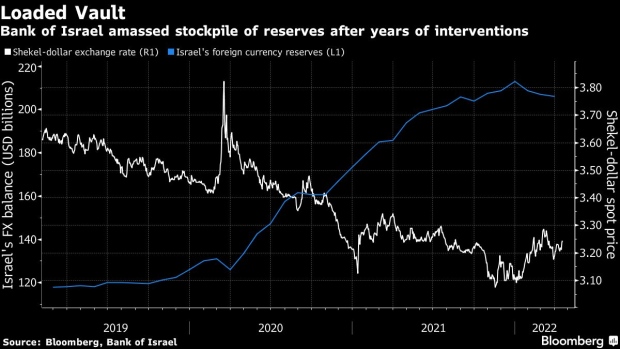Apr 20, 2022
Israel Adds Yuan to $206 Billion Reserves in ‘Philosophy’ Change
, Bloomberg News

(Bloomberg) -- Israel’s central bank has made the biggest changes to its allocation of reserves in over a decade, adding the Chinese yuan alongside three other currencies to a stockpile that last year exceeded $200 billion for the first time ever.
Starting this year, the currency mix will expand from the trio of the U.S. dollar, the euro and the British pound to include the Canadian and Australian dollars as well as the yen and the yuan, which is also known as the renminbi. The additions mark a change in the Bank of Israel’s “whole investment guidelines and philosophy,” Deputy Governor Andrew Abir said in an interview.
Following discussions held by the monetary committee last year, the pound and the yen will account for 5% and the currencies of Canada and Australia will have 3.5% each. Under the new approach, the yuan’s proportion is set at 2% for 2022, according to the Israeli central bank’s annual report published at the end of last month.
To accommodate the changes, the euro’s share will fall to 20% -- the lowest in at least a decade -- from just over 30%, while the dollar will account for 61%, down from 66.5%. The pound’s weighting, by contrast, will almost double to 5%, returning to a level last seen in 2011.
The “dramatic” rise in Israel’s foreign-exchange reserves led the central bank to lengthen its investment horizon, Abir said. “We look at the need to earn a return on the reserves that will cover the costs of liability.”
A program of currency interventions begun more than a decade ago by then-Governor Stanley Fischer to stem the surging shekel helped the central bank amass reserves that now surpass a third of gross domestic product. They stood at just over $206 billion at the end of March.
Israel’s shift in the allocation of its holdings brings it closer in line with the rest of the world, though it has yet to invest in another of the main global reserve currencies, the Swiss franc.
The International Monetary Fund’s survey on the currency composition of official foreign-exchange reserves shows that at the end of last year the euro accounted for close to 20%, the dollar for slightly less than 59% and the pound for almost 5%. The yuan rose slightly from the third quarter to a new high of 2.79%.
The greenback’s share, by contrast, has fallen to the lowest since 1995, largely to the benefit of the euro, the pound, the Canadian dollar and the yuan. The recent seizure of much of Russia’s foreign currency holdings as part of international sanctions over its invasion of Ukraine could prompt countries further to reconfigure their reserves.
Bigger Sway
China has pushed for a bigger international role of its currency, though the yuan’s prospects are held back by its limited convertibility and tight management by authorities. Still, recent reports that Saudi Arabia is in talks with Beijing to price some oil sales in the yuan have only added to speculation the currency will expand its global use in commodity trades as it benefits from accelerated de-dollarization in the wake of the Russia-Ukraine war.
Latin American countries have invested close to $30 billion in yuan assets over the last five years, according to Goldman Sachs Group Inc. In a March report, analysts at the Wall Street bank said Israel has also “made some key diversification shifts” and added more than $1 billion of yuan reserves in February alone.
Israel’s new currency basket also reflects the transformation of the country’s trade flows as it developed a booming technology industry with a global reach and discovered offshore natural gas to become self-sufficient and even export the fuel.
While the U.S. is still Israel’s biggest trade partner ahead of China, according to data compiled by Bloomberg, overall volumes with the Asian economy have surged, almost doubling between 2016 and 2021. In Europe, Germany and Switzerland account for the most trade with Israel.
©2022 Bloomberg L.P.






